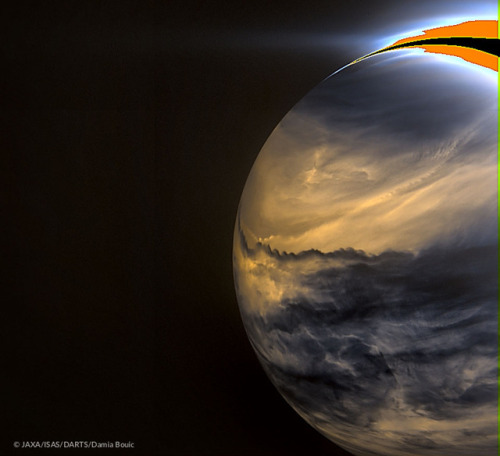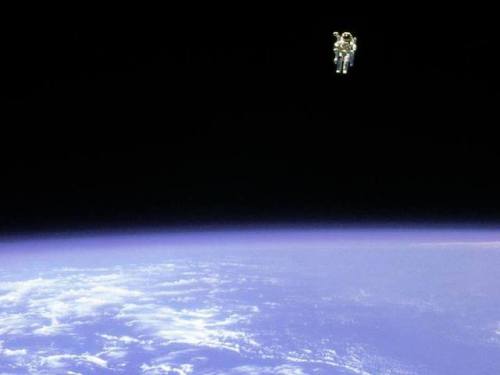Venusearthpassage - SpaceTransit



More Posts from Venusearthpassage and Others
'Sail-Rover' could make Venus exploration possible.

NASA’s Innovative Advanced Concepts program is funding a study into the possible use of a sail powered rover to explore the 500°C surface temperatures of Venus.
Read More
NASA considering cloud cities and air ships for manned mission to Venus
Cloud cities. On Venus. No, this is not the pitch for a potentially awesome science fiction story — this is a real-life proposal currently being considered by NASA.
Though Venus’s surface is far too volatile for us to visit anytime soon, scientists believe there’s a “sweet spot” in the Venusian atmosphere that would be the perfect place to fly some exploratory air ships and eventually establish a legit cloud city. Even better? They think it could be a whole lot easier than going to Mars. Well, kinda.
At approximately 31 miles above the planet’s surface, you’ll find one atmosphere of pressure and gravity just a tad lower than that of Earth. The average temperature, though admittedly hot, is just 17 degrees (Celsius) above the average Earth temperature. Hot, sure, but not unmanageable. Compare that to the wasteland of Mars, and it doesn’t sound too bad. Plus, since Venus is closer to the sun than Earth, that height is the perfect spot to tap into solar power — which could keep the ships (and cities?) running forever.
The Space Mission Analysis Branch of NASA’s Systems Analysis and Concepts Directorate at Langley Research Center is working on a proposal to send a robotic probe followed by manned air ships to the planet, leading to a permanent settlement. The five phases would include robotic exploration, a crewed mission to orbit on a 30-day mission, a crewed mission to the atmosphere on a 30-day mission, a crewed mission to the atmosphere for one year and finally a permanent human presence.
So, why might this be easier (in some ways) than a mission to Mars? The distance involved. A round-trip jaunt to Venus (440 days) would take almost half the travel time as a mission to Mars (650-900 days). But that doesn’t mean every aspect is easier. As IEEE Spectrum’s Evan Ackerman noted in a report that quotes NASA scientist Dale Arney, putting all the pieces together in motion above an alien planet wouldn’t be for the faint of heart:
The crewed mission would involve a Venus orbit rendezvous, where the airship itself (folded up inside a spacecraft) would be sent to Venus ahead of time. Humans would follow in a transit vehicle (based on NASA’s Deep Space Habitat), linking up with the airship in Venus orbit.
Since there’s no surface to land on, the “landing” would be extreme, to say the least. “Traditionally, say if you’re going to Mars, you talk about ‘entry, descent, and landing,’ or EDL,” explains Arney. “Obviously, in our case, ‘landing’ would represent a significant failure of the mission, so instead we have ‘entry, descent, and inflation,’ or EDI.” The airship would enter the Venusian atmosphere inside an aeroshell at 7,200 meters per second. Over the next seven minutes, the aeroshell would decelerate to 450 m/s, and it would deploy a parachute to slow itself down further. At this point, things get crazy. The aeroshell would drop away, and the airship would begin to unfurl and inflate itself, while still dropping through the atmosphere at 100 m/s. As the airship got larger, its lift and drag would both increase to the point where the parachute became redundant. The parachute would be jettisoned, the airship would fully inflate, and (if everything had gone as it’s supposed to), it would gently float to a stop at 50 km above Venus’s surface.
Considering the whole world is focused on Mars these days, even the team behind the proposal notes it’s unlikely for the focus to shift anytime soon. But the project is still a fascinating pitch. Seriously, can you even imagine a real-life Cloud City? Lando would be proud.
(Via io9, IEEE Spectrum)

“Venus at Night in Infrared from Akatsuki” Is the NASA Astronomy Picture of the Day of today, January 30, 2018

Meet Bruce McCandless. He was a bit of a bad-ass. In 1984, Bruce was aboard the Challenger Space Shuttle and became the first human to walk in space without a safety line. By utilising a nitrogen propelled Manned Maneuvering Unit (MMU), he stepped free from Challenger into the blackness of space for a 90-minute space walk and wandered as far as 97 meters from the ship. The result is this amazing image which captures ingenuity, innovation and most certainly bravery.
Bruce McCandless died yesterday at the age of 80.
-Jean Image Credit: NASA
Could we create dark matter?
85% of the matter in our universe is a mystery. We don’t know what it’s made of, which is why we call it dark matter. But we know it’s out there because we can observe its gravitational attraction on galaxies and other celestial objects.

We’ve yet to directly observe dark matter, but scientists theorize that we may actually be able to create it in the most powerful particle collider in the world. That’s the 27 kilometer-long Large Hadron Collider, or LHC, in Geneva, Switzerland.

So how would that work? In the LHC, two proton beams move in opposite directions and are accelerated to near the speed of light. At four collision points, the beams cross and protons smash into each other.

Protons are made of much smaller components called quarks and gluons.

In most ordinary collisions, the two protons pass through each other without any significant outcome.

However, in about one in a million collisions, two components hit each other so violently, that most of the collision energy is set free producing thousands of new particles.

It’s only in these collisions that very massive particles, like the theorized dark matter, can be produced.

So it takes quadrillions of collisions combined with theoretical models to even start to look for dark matter. That’s what the LHC is currently doing. By generating a mountain of data, scientists at CERN are hoping to find more tiny bumps in graphs that will provide evidence for yet unknown particles, like dark matter. Or maybe what they’ll find won’t be dark matter, but something else that would reshape our understanding of how the universe works entirely.
And that’s part of the fun at this point. We have no idea what they’re going to find.
From the TED-Ed Lesson Could we create dark matter? - Rolf Landua
Animation by Lazy Chief

This is an image of Venus taken in 1974 by NASA’s Mariner 10 space probe. The planet is blanketed by a thick veil of clouds high in carbon dioxide.

I’ve finally got round to continuing with my series of photos about the planets of the solar system! Next on my list is Venus. Venus is the second closest planet to our home star and notable for many strange oddities. For example, it has a rotational period of 243 days, whilst a year takes just 225 days. It has a diameter of ~12100km, making it very similar in size to Earth. It is often compared to Earth as its so-called twin planet, which may be true for aspects such as mass, size and proximity to the sun, but for almost everything else, they are vastly different.
Weiterlesen
Shared from Sky News: Venus has more volcanoes than we thought - and this map shows where they are


When it landed on Venus on December 15th, 1970, Venera 7 became the first spacecraft to achieve a soft-landing on another planet. Only able to transmit surface data back to Earth for 23 minutes due to signal degradation, it was determined by Venera 7’s transmission that the atmosphere of Venus is composed 97% of carbon dioxide, with a temperature reading of 887°F (475°C).

ASTEROID DAY 2018
On 30 June 1908, 110 years ago, a 40 m asteroid struck the Earth over Tunguska, Siberia.
Destroying an area of forest the size of Greater London, this was the most significant impact event in Earth’s recent history.
Now recognised by the United Nations as Asteroid Day, 30 June marks a global opportunity to raise awareness of the threat and opportunity posed by the numerous rocky bodies traversing space.
Since 2009, ESA has played a leading role in the global hunt for risky asteroids and comets – known formally to astronomers as near-Earth objects (NEO) – and is currently developing cutting-edge widefield telescopes that will have the ability to scan the entire sky in just 48 hours.
ESA also carries out crucial analysis as part of its Space Situational Awareness (SSA) programme and mobilises observatories and astronomers worldwide through its SSA NEO Coordination Centre at the Agency’s ESRIN facility in Italy.
Each year, Asteroid Day is broadcast live across the globe with a packed programme that brings together astronauts, rock stars and scientists.
Highlighting our potentially vulnerable place in space, the live event also describes the many ingenious and yet not-far-from scifi potential solutions to these dangerous roaming rocks.
Each year hundreds of regional events also take place, with 78 countries so far having hosted concerts, community events, lectures and much more.
-
 riordanversezine liked this · 1 year ago
riordanversezine liked this · 1 year ago -
 westpertiavertcum liked this · 1 year ago
westpertiavertcum liked this · 1 year ago -
 wisteriastarlight liked this · 3 years ago
wisteriastarlight liked this · 3 years ago -
 coconelpastel liked this · 4 years ago
coconelpastel liked this · 4 years ago -
 astrotracksuitbattalion liked this · 5 years ago
astrotracksuitbattalion liked this · 5 years ago -
 crystalsenergy liked this · 5 years ago
crystalsenergy liked this · 5 years ago -
 boyslikemargie liked this · 5 years ago
boyslikemargie liked this · 5 years ago -
 surrupiar liked this · 5 years ago
surrupiar liked this · 5 years ago -
 nao-j9 liked this · 5 years ago
nao-j9 liked this · 5 years ago -
 rainyanxiety liked this · 5 years ago
rainyanxiety liked this · 5 years ago -
 ethereal222 liked this · 5 years ago
ethereal222 liked this · 5 years ago